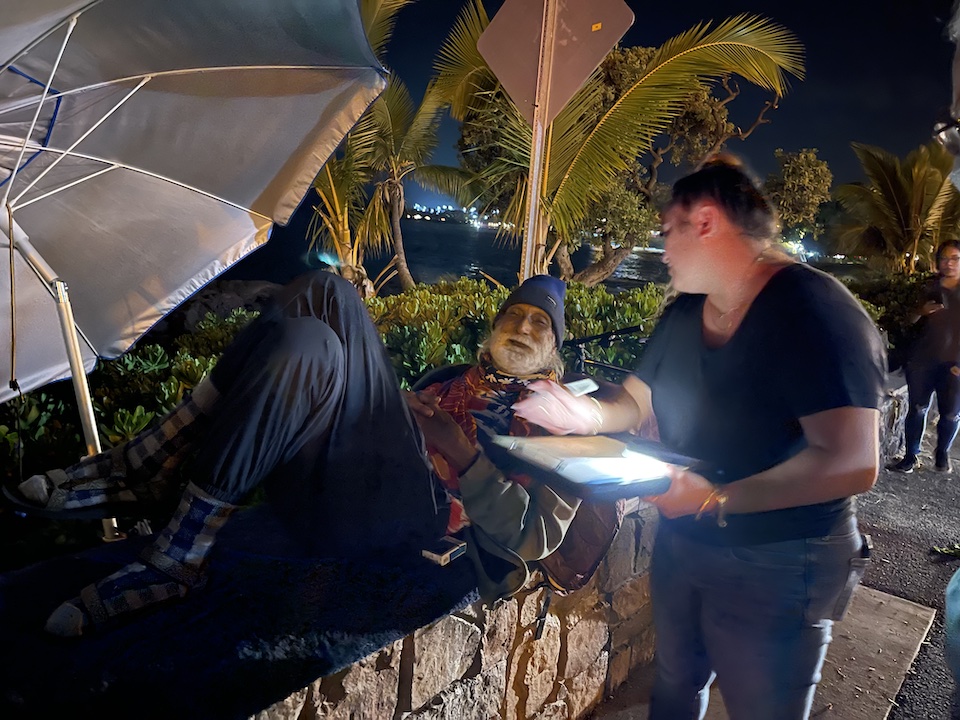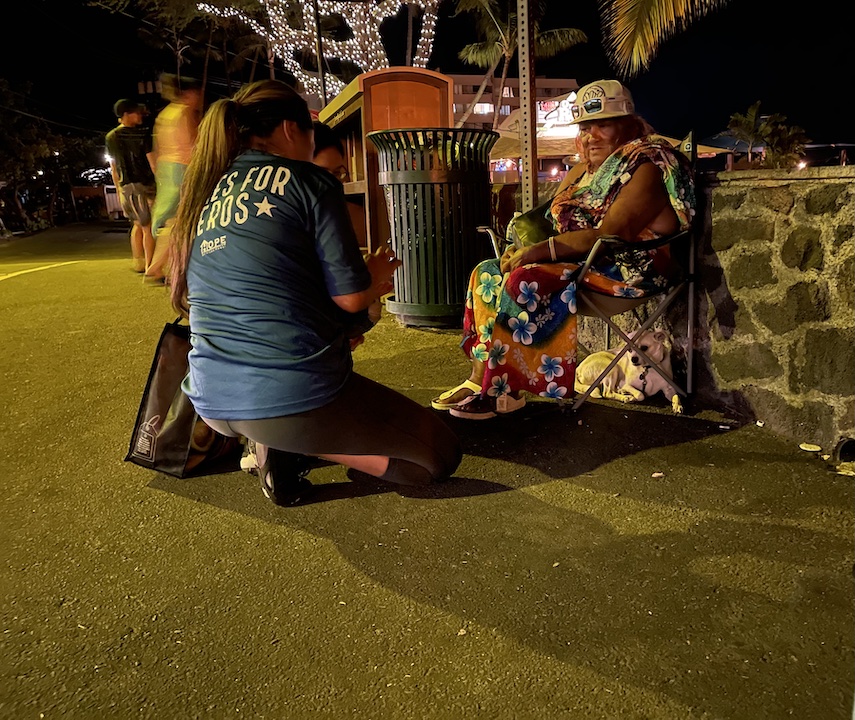Big Island families, individuals sleeping in cars, benches, bushes tell their stories

In the corner of a nearly empty Kona parking lot on a nippy Thursday night, an 18-month-old boy is running barefoot in circles, laughing, as Brandee Menino playfully chases him.
The toddler, wearing diapers and a long-sleeve shirt, ran to his mother and then his large yellow dog Duke, who showered him with licks on his face as he giggled uncontrollably.
Nearby was his father, standing next to a dark-colored hatchback, crammed with clothes and other belongings. The car is their home.
“What’s your name?” Lahi Kanakanui, an adult mental health housing navigator for Hope Services Hawaiʻi outreach, asked the father. “How long have you been living out of your car?”
The three family members are among the people without homes on the west side of the Big Island who were being counted Thursday night as part of the federally mandated annual Homeless Point in Time Count.
For the past week, volunteers and members of outreach with the nonprofit Hope Services Hawaiʻi, led by Menino, have been going to every corner of the island, hitting the streets, parks, beaches, bushes and parking lots looking for people to take the Point in Time survey.

The federal government looks at the numbers nationwide to determine how to allocate funds for the homeless in the various communities across the country. The data collected provides insight into how many people are homeless on a given night. This year, outreach and volunteers are asking people: “Where did you sleep on January 22?”
For the couple and their young child, they slept in their car. The father, who was in his 20s, told Kanakanui he’d been living in his vehicle with his girlfriend and young child for about five months.
“We need to get out of this box,” he said as he lightly kicked one of the back tires of the vehicle that is falling apart.
The girlfriend didn’t want to be identified due to the negative stigma that comes with being homeless. While she and her boyfriend have been unhoused in the past, she said this time is different because they now have a child.

“We’re making sure he has some kind of schedule,” she said.
Both she and her boyfriend work part-time jobs but they can’t get anything full-time because they’d need child care. She said she recently signed up to do Door Dash as a way to make extra money.
The parking lot was one of several locations the seven-person outreach team hit during a stint from 6:30 to 10 p.m. on Thursday. They also handed out food, blankets, hygiene products, beanies and jackets as well as Narcan, a nasal spray that reverses the effects of a drug overdose.
Carrie Hoʻopiʻi, outreach team leader for Hope Services, said the count has been going great: “Not only are we locating them, they’re engaging with us, and that’s the best part. Past years it was a problem as they weren’t aware for the need of the survey.”
The outreach team did a lot of work this year to inform the homeless community about the survey and its purpose.
“It’s hard to find families because they don’t want to be noticeable,” Hoʻopiʻi said. “They believe it will hinder the custody of their children.”
For homeless families, Hoʻopiʻi said it’s hard for parents, who are sacrificing their basic needs to make it through the night with their keiki.
The small team conducted at least 50 surveys Thursday.
After leaving the parking lot, the group went to Aliʻi Drive and parked by Hale Halawai. They walked among the hustle and bustle of Kona’s night life to talk with the homeless men and women congregated on the sea wall across from Coconut Grove, a food and shopping area, as the surf crashed behind them.

Paul Schneider, 49, has been homeless for four years despite saying he has a full-time job as a cook at a Kona restaurant. He said the three most important things to remember while living on the street are: keep your stuff clean, don’t let your stuff get stolen and try not to piss people off.
Schneider said recently his hammock, pillow and everything he uses to keep warm were stolen.
Next to Schneider on the sea wall was a man in his 60s who called himself “OG,” which stands for “Old Guy.”
Lying on a blanket on the rock wall, and bundled from head to toe with socks, jacket and a beanie, OG said he lives on the streets by choice: “I could get a hotel if I wanted to.”
And, he said he does do so occasionally in order for his buddy Schneider to be able to take a hot shower.
OG said the hardest thing about being homeless is the assumptions people make of you. But he said Kona is the epitome of the Aloha spirit with most people kind and giving.
Further down the wall was Carrie Ann Gouveia, 67, who has been homeless for three years and has heart issues and seizures. Sitting in a camping chair, with a small dog curled up by her feet, she said the other homeless respect her.
“A lot of them love me and take care of me,” Gouveia said.
Many homeless people will come and talk to her when they need help. She said: “Not all of them are bad.”
As the outreach workers passed out food and warm clothes, Gouveia took at least two boxes of Narcan for “the idiots.”
One homeless man refused Narcan as he proudly declared he’d been clean from drugs for 2 1/2 weeks.
As the night pushed on, Ho’opi’i and her team visited parked cars sheltering people along a Kona roadway. Several people took the survey.
“If they’re will to talk to us at this hour — strangers — they’re ready for help,” Hoʻopiʻi said. “I wish I could take them all home.”
They hardest part of these encounters, Hoʻopiʻi said, is when she has to leave them, knowing there’s no immediate solution to their housing problem.
Volunteer Cindy Whitehawk came out with the outreach team twice this past week. One encounter that stuck out to her was a husband and wife on the cement. The woman was crying and her husband was screaming from intense pain from possibly gout.
“It broke my heart,” Whitehawk said.
The woman told Whitehawk: “I hate my life. I’m too old for this.” Whitehawk was able to talk to her and calm her down and Hope Services was able to help them get into a shelter together.
“A lot of people forget these homeless [individuals] are people, too,” she said. “A lot of people are just one paycheck away from being homeless.”
There are 12 shelters on Hawaiʻi Island, eight of which are operated by Hope Services. On Thursday night, Menino said out of the facilities they run there were only three beds available and they were all in the men’s shelter in Hilo.
The state and Hawaiʻi County are working to provide more temporary shelters and services for the homeless.
Hours before Hope Services began their last day of conducting the 2023 survey, Hawaiʻi Gov. Josh Green flew to Kona to participate in the blessing and groundbreaking of Kukuiola, a new tiny home village for the homeless, which will eventually have 64 units and a one-shop center for services.
Depending on the results of the Point in Time Count, outreach workers say it could open doors to more resources to the homeless community on the Big Island. Menino has been monitoring the bills about homeless issues that are being presented during this State Legislature session.
She said: “We don’t want to be left out when resources become available.”













